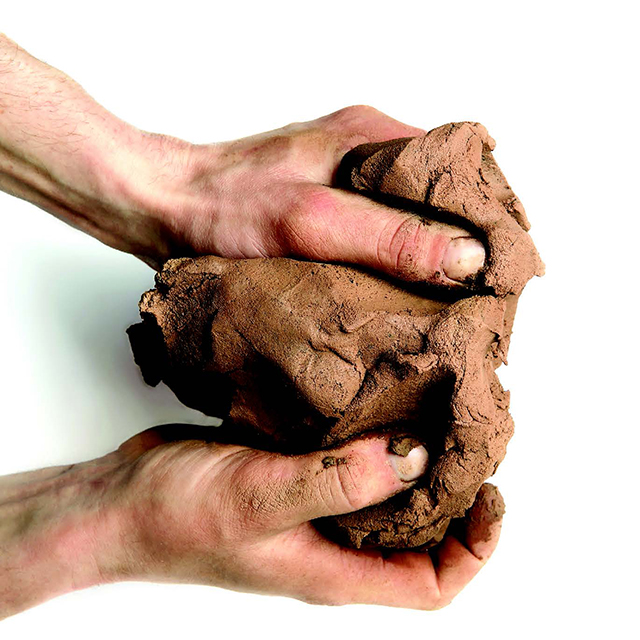Mobilising industry for a clean and circular economy
Ceramic Roadmap
TO 2050
The European ceramic industry supports Europe’s goal to move away from a linear ‘produce, use, waste’ model to a circular model in which resources and materials are reused, recycled, or recovered.
Resource efficiency is not only about using less, but about making better use of existing resources. Clay, our industry’s main raw material, is available in abundance. Furthermore, ceramic products are resource-efficient and stand out with their high durability thanks to their long lifespan. And after the end-of-life stage, ceramic products can be reused or recycled.
The ceramic industry is already making a major contribution to the shift towards a circular economy through innovative production processes and sustainable products – for example, by minimising raw material consumption and waste generation during the production process, optimising raw material selection, refining product design and promoting supply-chain cooperation for recycling.
Durability
Resource efficiency is not only about ‘using less’, but about ‘using better’. Ceramic products, and in particular ceramic construction products, are resource-efficient and have a high durability, requiring little or no maintenance. Studies show that a brick house can have an average life span of more than 150 years, as do clay pipes and buildings containing expanded clay. Research also shows that clay pavers can have a lifetime of 125 years. Sanitaryware appliances and ceramic tiles for flooring and walls can have a life span of up to 50 years, which is very high in comparison to alternative materials. Ceramic tableware and ornamentalware can last for decades.
Moreover, given the inert nature of fired clay, many ceramic products can be reused or recycled after the end-of-life stage, meeting the concept of cradle-to-cradle. In this context, the ceramic industry has developed solutions to minimise raw material consumption and waste generation during the production process, and has increased the reuse and recycling of products.
Innovation
Research and innovation in the ceramic industry has transformed the manufacturing process and the efficiency of raw materials. The industry has accomplished this through innovative technologies and product developments, the substitution of primary raw materials with recycled materials, the direct internal reuse or recycling of materials and the substitution of conventional fuels. In recent years, research has also focused on product design, in which digitalisation plays a key role. In the wall and floor tiles industry, some manufacturers have switched from rotary printing to digital printing: ceramic inks can be used instead of decorative pastes, so that only 20% of the raw material previously needed is used. Research on the application of digital printing in the glazing process suggests it offers great potential.
The circular economy in action
Bricks and Blocks
The use of internal production residues from brickmaking as a substitute for raw materials is common practice across the industry. Broken clay blocks can also be crushed to different sizes and used as a lightweight aggregate for making concrete blocks.
Dry stack systems for facing bricks have also been developed. These are easily dismantled, and the bricks can be reused. Bricks can also be reused when using lime mortar for the brickwork. And brick manufacturers have developed hanging systems in which bricks or brick slips glued on panels are detachably connected to an underlying frame and can easily be reused.
Roof tiles
Roof tiles are easy to disassemble and have a very long service life. They can be reused or recycled for other purposes: backfilling in pits and quarries, water-bound cover layers, aggregates for substructure or surface layer in road construction, coverings for tennis courts and sports fields, vegetation substrate and roofing substrates for green roofs.
Clay pavers
Ceramic pavers are almost always reused, and they even increase in economic value. Clay pavers have a reuse percentage of at least 90% and an average lifespan of 125 years.
Wall and floor tiles
Ceramic wall and floor tiles are increasingly being repurposed, and work is ongoing aimed at achieving zero waste in the manufacture of ceramic tiles by using ceramic waste in the body and glaze. Several manufacturers are also looking at producing tiles that can be reused.
Clay pipes
The minimum share of external recycled content now averages above 20%. In the vitrified clay pipes industry, it is possible to produce 100% recyclable clay pipes, consisting of about 40% secondary raw materials on average, and with a service life of more than 100 years.
Expanded clay
In the expanded clay industry, up to 90% of the product can be reused. Up to 100% of expansion clay additives and 10-15% of virgin clay can be replaced by alternative materials derived from other industry sectors.
Policy recommendations
Promote durable products
Use of long-lasting, reusable and/or recyclable products such as ceramic products should be encouraged, and a whole lifecycle analysis should become binding.
Overcome regulatory obstacles
Regulatory obstacles hampering further development of circular practices in the industry should be lifted.
Facilitate shipment of waste
Shipment of waste between different Member States is a complex process and leads to administrative overburden. Waste destined to valorisation must benefit from the principle of free movement of goods within the EU.
End-of-waste criteria for refractory ceramics
End-of-waste and by-products criteria are not harmonised at European level. This ambiguity in current legislation involving waste and byproducts creates a ‘grey zone’ which can lead to different interpretation between the manufacturers and local authorities. The industry needs to work with local governments to facilitate the use of spent refractories and minimise administrative obstacles. Specific criteria should be established for refractories to lift these obstacles.
Incentivise circular practices
Developing circular practices and adapting technical requirements of installations can generate significant costs for the industry. Incentives should be developed to encourage these practices.


